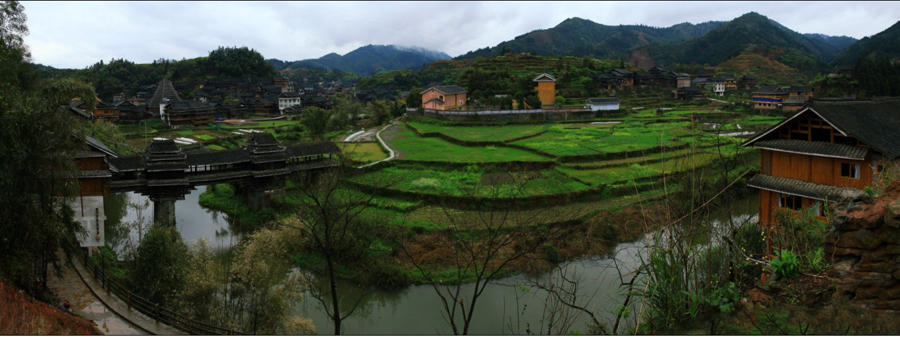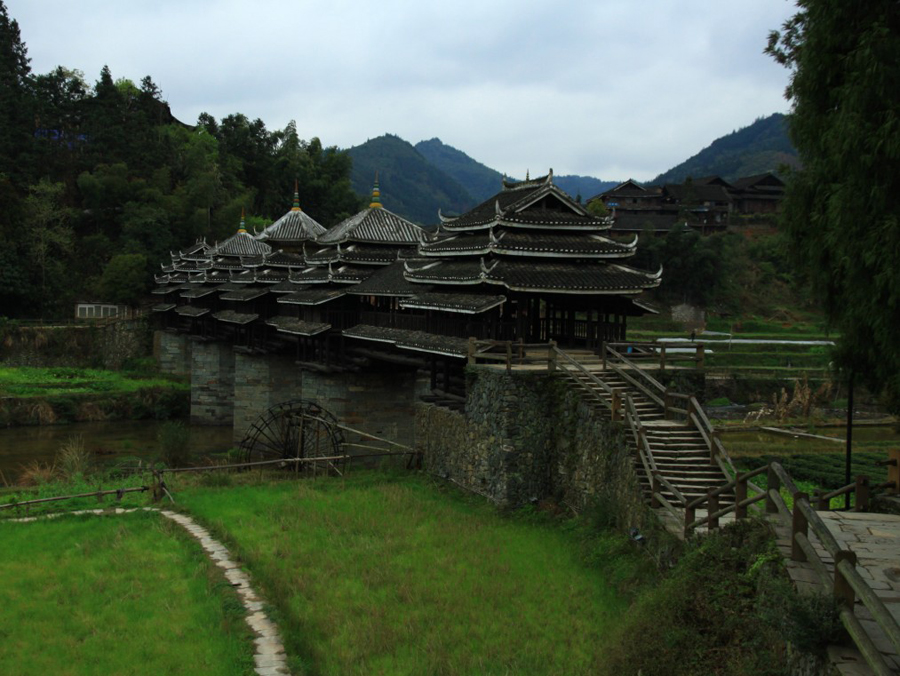
Sanjiang County, located in the cross sections of Guangxi, Hunan and Guizhou provinces, homes 2,197 families in eight Dong ethnic group villages, totaling 10,000 people. These villages represent the traditional Dong style and are famous for well-preserved Dong-style wood buildings, clothes, dance and other daily traditions. Its Chengyang Bridge under national key cultural relics protection is the largest wind-rain bridge in the world. Built in 1912, the structure is a combination of painting, bridge, corridor, veranda and Chinese pavilion. [dili360.com/ by ????] 
Sanjiang County, located in the cross sections of Guangxi, Hunan and Guizhou provinces, homes 2,197 families in eight Dong ethnic group villages, totaling 10,000 people. These villages represent the traditional Dong style and are famous for well-preserved Dong-style wood buildings, clothes, dance and other daily traditions. Its Chengyang Bridge under national key cultural relics protection is the largest wind-rain bridge in the world. Built in 1912, the structure is a combination of painting, bridge, corridor, veranda and Chinese pavilion. [dili360.com/ by ????] 
Sanjiang County, located in the cross sections of Guangxi, Hunan and Guizhou provinces, homes 2,197 families in eight Dong ethnic group villages, totaling 10,000 people. These villages represent the traditional Dong style and are famous for well-preserved Dong-style wood buildings, clothes, dance and other daily traditions. Its Chengyang Bridge under national key cultural relics protection is the largest wind-rain bridge in the world. Built in 1912, the structure is a combination of painting, bridge, corridor, veranda and Chinese pavilion. [dili360.com/ by ????] 
Sanjiang County, located in the cross sections of Guangxi, Hunan and Guizhou provinces, homes 2,197 families in eight Dong ethnic group villages, totaling 10,000 people. These villages represent the traditional Dong style and are famous for well-preserved Dong-style wood buildings, clothes, dance and other daily traditions. Its Chengyang Bridge under national key cultural relics protection is the largest wind-rain bridge in the world. Built in 1912, the structure is a combination of painting, bridge, corridor, veranda and Chinese pavilion. [dili360.com/ by ????] 
Sanjiang County, located in the cross sections of Guangxi, Hunan and Guizhou provinces, homes 2,197 families in eight Dong ethnic group villages, totaling 10,000 people. These villages represent the traditional Dong style and are famous for well-preserved Dong-style wood buildings, clothes, dance and other daily traditions. Its Chengyang Bridge under national key cultural relics protection is the largest wind-rain bridge in the world. Built in 1912, the structure is a combination of painting, bridge, corridor, veranda and Chinese pavilion. [dili360.com/ by ????] 
Sanjiang County, located in the cross sections of Guangxi, Hunan and Guizhou provinces, homes 2,197 families in eight Dong ethnic group villages, totaling 10,000 people. These villages represent the traditional Dong style and are famous for well-preserved Dong-style wood buildings, clothes, dance and other daily traditions. Its Chengyang Bridge under national key cultural relics protection is the largest wind-rain bridge in the world. Built in 1912, the structure is a combination of painting, bridge, corridor, veranda and Chinese pavilion. [dili360.com/ by ????] 
Sanjiang County, located in the cross sections of Guangxi, Hunan and Guizhou provinces, homes 2,197 families in eight Dong ethnic group villages, totaling 10,000 people. These villages represent the traditional Dong style and are famous for well-preserved Dong-style wood buildings, clothes, dance and other daily traditions. Its Chengyang Bridge under national key cultural relics protection is the largest wind-rain bridge in the world. Built in 1912, the structure is a combination of painting, bridge, corridor, veranda and Chinese pavilion. [dili360.com/ by ????] 
Sanjiang County, located in the cross sections of Guangxi, Hunan and Guizhou provinces, homes 2,197 families in eight Dong ethnic group villages, totaling 10,000 people. These villages represent the traditional Dong style and are famous for well-preserved Dong-style wood buildings, clothes, dance and other daily traditions. Its Chengyang Bridge under national key cultural relics protection is the largest wind-rain bridge in the world. Built in 1912, the structure is a combination of painting, bridge, corridor, veranda and Chinese pavilion. [dili360.com/ by ????] 
Sanjiang County, located in the cross sections of Guangxi, Hunan and Guizhou provinces, homes 2,197 families in eight Dong ethnic group villages, totaling 10,000 people. These villages represent the traditional Dong style and are famous for well-preserved Dong-style wood buildings, clothes, dance and other daily traditions. Its Chengyang Bridge under national key cultural relics protection is the largest wind-rain bridge in the world. Built in 1912, the structure is a combination of painting, bridge, corridor, veranda and Chinese pavilion. [dili360.com/ by ????] 
Sanjiang County, located in the cross sections of Guangxi, Hunan and Guizhou provinces, homes 2,197 families in eight Dong ethnic group villages, totaling 10,000 people. These villages represent the traditional Dong style and are famous for well-preserved Dong-style wood buildings, clothes, dance and other daily traditions. Its Chengyang Bridge under national key cultural relics protection is the largest wind-rain bridge in the world. Built in 1912, the structure is a combination of painting, bridge, corridor, veranda and Chinese pavilion. [dili360.com/ by ????] 
Sanjiang County, located in the cross sections of Guangxi, Hunan and Guizhou provinces, homes 2,197 families in eight Dong ethnic group villages, totaling 10,000 people. These villages represent the traditional Dong style and are famous for well-preserved Dong-style wood buildings, clothes, dance and other daily traditions. Its Chengyang Bridge under national key cultural relics protection is the largest wind-rain bridge in the world. Built in 1912, the structure is a combination of painting, bridge, corridor, veranda and Chinese pavilion. [dili360.com/ by ????] 
Sanjiang County, located in the cross sections of Guangxi, Hunan and Guizhou provinces, homes 2,197 families in eight Dong ethnic group villages, totaling 10,000 people. These villages represent the traditional Dong style and are famous for well-preserved Dong-style wood buildings, clothes, dance and other daily traditions. Its Chengyang Bridge under national key cultural relics protection is the largest wind-rain bridge in the world. Built in 1912, the structure is a combination of painting, bridge, corridor, veranda and Chinese pavilion. [dili360.com/ by ????] 
Sanjiang County, located in the cross sections of Guangxi, Hunan and Guizhou provinces, homes 2,197 families in eight Dong ethnic group villages, totaling 10,000 people. These villages represent the traditional Dong style and are famous for well-preserved Dong-style wood buildings, clothes, dance and other daily traditions. Its Chengyang Bridge under national key cultural relics protection is the largest wind-rain bridge in the world. Built in 1912, the structure is a combination of painting, bridge, corridor, veranda and Chinese pavilion. [dili360.com/ by ????] |